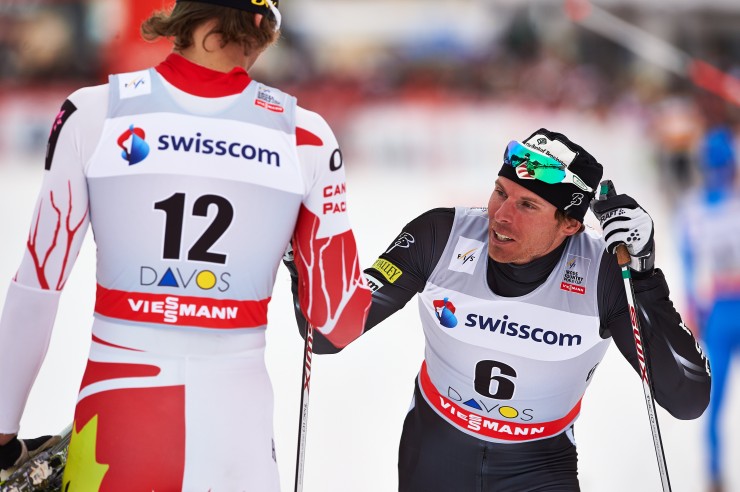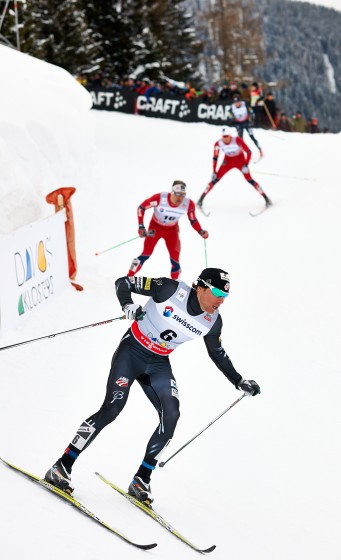
It didn’t matter how close Andy Newell came to the podium this season, the 28-year-old US Ski Team veteran always said he wanted more. It’s not like he hadn’t been there before – Newell won silver in a World Cup skate sprint in 2008 and placed third in a World Cup classic sprint after the 2010 Olympics – but the latter came almost three years ago.
Already this season, the Vermont native made it into three sprint finals, where he placed fifth twice and also sixth. Not good enough, he thought. Still, the consistency was positive, and it put Newell in contention for the World Cup sprint title.
On Saturday, the Stratton Mountain School T2 Team skier came one step closer to that Crystal Globe, moving to second in the sprint standings just 34 points behind Sweden’s Emil Jönsson. To do so, Newell notched fourth in the 1.5-kilometer classic sprint in Davos, Switzerland, qualifying in sixth then winning his quarterfinal and placing second in the semifinal for a considerably dominant day. He ran out of gas in the final, but acknowledged the strength of Kazakhstani winner Alexey Poltoranin, whom he challenged in the semifinal.
“It was frustrating not to be the on the podium,” Newell said on the phone after finishing 9.09 seconds behind Poltoranin in the final on 0.41 back from him in the semi. “He’s for sure probably the best classic skier I think in the world when it comes to uphill striding so he’s obviously a hard guy to hang with on the uphill.”
Switzerland’s Dario Cologna was second (+5.49) and Frederico Pellegrino of Italy placed third (+6.02) ahead of Newell, who said they were within reach.

“I could totally see Pellegrino slipping a little bit and Dario, and I just got right on their asses,” Newell said with a laugh. “I was really hoping for that podium, but I just lost a little too much over the top of the hill unfortunately.”
With a two-lap sprint course marked by a technical uphill turn and long double-pole finish, Newell felt it was critical to play his cards right and not blow up. He conserved appropriately, adding more kick wax after the qualifiers then being careful not to lead the first lap while controlling the pace. He won his quarterfinal by 1.13 seconds over Norway’s Kent Ove Clausen, and went with Poltoranin in the semi to gap the field and advance in second.
Fellow US Ski teamer Simi Hamilton (Sun Valley Ski Education Foundation) joined Newell in the third quarterfinal after qualifying in fifth. However, Hamilton struggled with his start in the heat and got caught up in traffic early on. Despite a strong double-pole finish, he took third in the photo finish with Clausen.
The first-quarterfinal winner, Cologna had thrown down a blistering pace – more than three seconds faster than Newell’s quarterfinal time. That eliminated Hamilton’s shot at advancing as a lucky loser and he ended up 13th for an individual season best.
“In the past, long and gradual double poles have been a bit of a weakness for me, so I am psyched with my finishing speed in the quarter,” Hamilton wrote in an email. “But still, to be so close to a lucky loser spot after fighting very hard is frustrating. It will come though.”
U.S. coach Matt Whitcomb was impressed with the team’s performance on Saturday, one of two days of World Cup racing less than a week before World Championships begin in Val di Fiemme, Italy.
“We had a really good day; it’s the kind of day we wanted to have before going to World Champs and our sprinters will go there with some good confidence now,” Whitcomb said.
He called Newell’s move to second in the sprint standings “an enormous deal” paired with the season-long achievements of Kikkan Randall, who is 134 points ahead as the women’s sprint leader.
“It’s a pretty cool thing for the U.S. team,” Whitcomb said. “[Newell] looked great today. It was maybe a course that aerobically challenged Sochi, certainly technically it exceed Sochi, and to be able to look good on a course like that is quite a feat. I’d pair Simi in that category, too, so we’re feeling good about this.”
The good news for Newell, who felt a little flat in the qualifier after taking it easier in training this week, is that if he doesn’t reach that coveted podium in the classic sprint at World Championships, there’s always the rest of the season.
“I’ve had four finals so far this year and no podiums,” Newell said. “I think that’s making me even more hungry to get one in at World Champs and if not there then sometime in the next few weeks. … I’m really excited to keep racing after world champs, too. Emil’s definitely not out of striking distance [for the World Cup sprint title] so it’s going to be a really cool battle for the rest of the year for that.”
Two other Americans in Saturday’s sprint, Dakota Blackhorse-von Jess (Bend Endurance Academy) placed 52nd (+14.92) and Erik Bjornsen (US Ski Team/Alaska Pacific University) was 66th in the qualifier.
For Blackhorse-von Jess, who was about six seconds out of qualifying, his first World Cup race in Europe was all about the experience. Interestingly, he wrote in an email that he felt less pressure than say, U.S. Nationals, where he expects to win qualifiers.
“Today, I was loose and relaxed, had a plan, and went out and tried to execute,” Blackhorse-von Jess explained. “The only real difference is that this course is harder than anything we’ve raced back home.
“I thought I did a really good job following my plan and felt really good and really encouraged going into the climbs the second lap,” he added. “Stayed loose, hammered the double pole between the laps and could tell I was in the mix. Then… I exploded. Hard to ski up big hills when you’re flooded like that. Elevation racing, ha.”
Disappointed with his result at 1,560 meters (5,120 feet) above sea level, Blackhorse-von Jess wrote that he’s still feeling great about his skiing.
“Today’s result is not an indication of how [the World Cups in] Lahti and Drammen will go other than to be an encouragement that if I was only 6 seconds out of qualifying given how badly I came apart at the end, everything is gonna be okay,” he wrote.
Bjornsen wasn’t happy where he ended up after crashing on the skied-out downhill corner.
“I knew that if I went hard through the corner both times I could probably make up a couple seconds even though it was a little risky,” Bjornsen wrote. “I hammered over the top of the hill and didn’t slow my speed down at all and when I hit the icy section I was not able to stay upright. After I fell I skied the rest of the course hard, but it’s really difficult to be motivated after a fall because as soon as you fall in a sprint race your day is over.”
Looking forward, Bjornsen’s still shooting for a top 30 and feels it’s possible to get there.
“I feel like I’m in the best shape of my life right now,” he wrote. “I just know I have to have an exceptional race and be willing to take the risk of falling or blowing up.”
— Audrey Mangan contributed reporting
Alex Kochon
Alex Kochon (alexkochon@gmail.com) is a former FasterSkier editor and roving reporter who never really lost touch with the nordic scene. A freelance writer, editor, and outdoor-loving mom of two, she lives in northeastern New York and enjoys adventuring in the Adirondacks. She shares her passion for sports and recreation as the co-founder of "Ride On! Mountain Bike Trail Guide" and a sales and content contributor at Curated.com. When she's not skiing or chasing her kids around, Alex assists authors as a production and marketing coordinator for iPub Global Connection.



